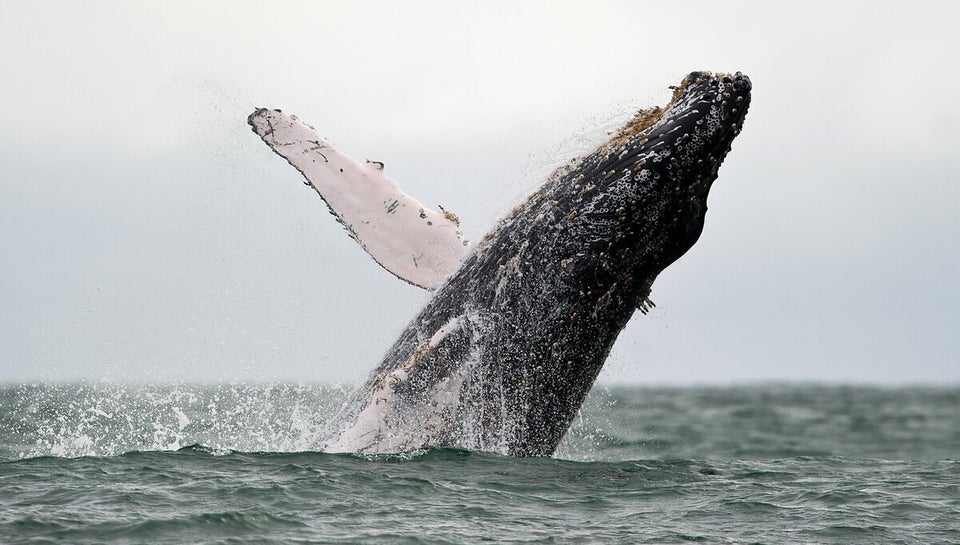When it comes to the environment, few issues are more controversial than the conservation of whales. Overhunting drove many species to the brink of extinction, but a sustained global conservation effort has successfully brought some of these creatures back from the edge.
So when the announcement was made that humpback whales would no longer be protected as a "threatened" species in Canada, the public was furious. To many, this represented positive proof that the federal government would do anything to promote the Northern Gateway pipeline -- including meddling with the protection of humpback whales to get them out of the way of development.
Our government has a lot to answer for in the area of environmental management, but the outcry in this case is misguided. To understand why, we first need to understand how decisions are made about whether our country considers a given species to be threatened or endangered.
In Canada, species go through a two-step process that determines whether they receive special protection as a species at risk of extinction. In the first step, an independent group of scientists called the Committee on the Status of Endangered Wildlife in Canada (COSEWIC) reviews scientific information about the health of each species. They look at many factors, including how many individuals there are, whether the species is stable or in decline, and whether the threats that caused them to decline have been removed. One factor they do not consider is the cost of protection -- that comes later.
Once COSEWIC makes their assessment, their report is passed on to the federal government. In this second step, the government examines the costs and benefits of protection, and determines whether they will commit to listing the species under the Species at Risk Act (SARA). If listed, the species receives the full protection of SARA, cannot be harmed or killed, and its critical habitat must be identified and protected.
While the government is obligated to explain their decision if they elect not to list, these explanations have been criticized as being inconsistent, opaque and biased by taxonomy (for example, marine fish rarely get listed for protection, particularly if protection costs money).
Under this system, politics is limited to influencing the second step. Neither the government nor the general public has any say on the assessments that COSEWIC renders. Therefore, if humpback whales were downlisted for political reasons, then their listing under SARA should be less severe than the assessment made by COSEWIC -- for example, COSEWIC would have recommended a "threatened" assessment, with the government listing as "special concern." If that happened, it would represent an example of the government ignoring scientific evidence.
For humpback whales, this was not the case. In 2011, COSEWIC re-assessed the North Pacific population, and determined that increases in whale abundance, an annual population growth rate of 4.9 to 6.8 per cent, and the elimination of hunting have caused the species to recover to the point where it no longer qualifies for the special protections offered by SARA.
When COSEWIC assessed the North Pacific humpback as being of "special concern," Fisheries and Oceans Canada held public consultations, at which point some scientists made the argument that the species should be considered as two separate units rather than one. COSEWIC rejected this opinion and maintained that the species should be considered as a single unit. There are many arguments for and against this decision, but it was scientifically reasonable to consider the whales as one unit.
There is no evidence that the down-listing of the North Pacific population of humpback whales was due to political gamesmanship -- rather, it represents a conservation success story, albeit one that is not yet complete, and that Canada cannot take total credit for (that one goes to the sustained global fight against whaling). Now, humpback whales have been classified as "Least Concern" by the International Union for the Conservation of Nature, an internationally-recognized body that assesses the status of species around the world.
However, the recovery of humpback whales in B.C. is not an excuse to become complacent. The number of humpback whales in B.C.'s waters is still only about half of what it was 100 years ago, so a lot of work has yet to be done to bring this species back up to historic levels. In addition, there are many examples of the government failing to meet its obligations for species listed under SARA, which have been summarized within a scathing report by the Auditor General of Canada.
Furthermore, if our laws require that species be at risk of extinction before effective management measures come into effect, then we need to revise our laws. Conservation focused strictly on endangered species would be like health care based entirely around the emergency room, ignoring something like vaccines as a cost-effective approach that can reduce disease at a fraction of the cost.
One important step would be restoring the protection of fish habitat under the Fisheries Act -- protections that were recently reduced, in a move that was condemned by scientists and politicians across the political spectrum. Another would be to enforce conservation laws that are already on the books, including renewing the focus on identifying and protecting critical habitat, as is required by law.
However, in the case of the North Pacific population of humpback whales, we can draw satisfaction that here, at least, is an example of what we can do when we set our minds to protecting a species -- and the reclassification of the species from "threatened" to "special concern" should be seen as a success story. Nevertheless, it is a story that's not yet over.
ALSO ON HUFFPOST:
(This article previously appeared on the The Liber Ero blog)
